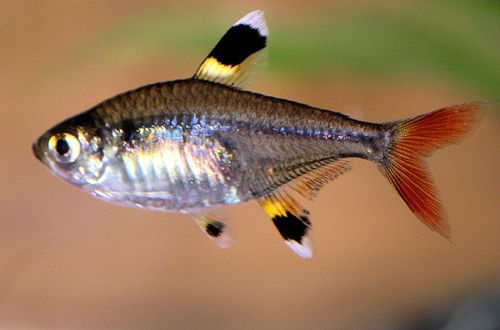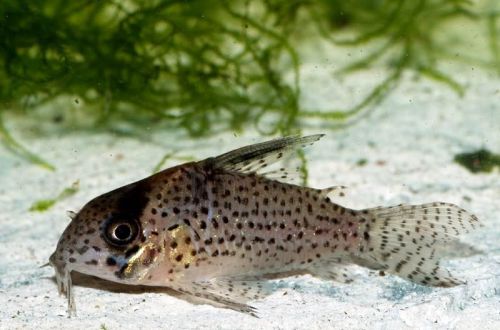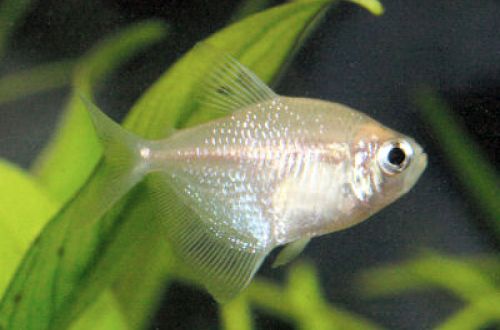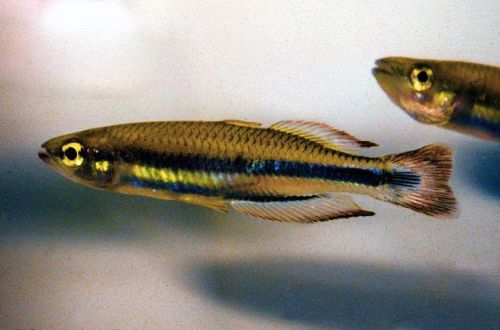
Transparent Tetra
Transparent Tetra, Goldfinch Fish or Pristella, scientific name Pristella maxillaries, belongs to the Characidae family. The fish has a surprising body color, or rather its complete absence. Looking at it, a feeling of transparency is created, you can clearly see the ridge and bones, as if you are looking at an x-ray. Simplicity and unpretentiousness in maintenance, coupled with unusual coloring, makes it an excellent option for beginner aquarists.

Contents
Habitat
This species is widely distributed throughout the Amazon and other major rivers of South America. They prefer small streams and channels with dense vegetation, during the rainy season they can migrate to flooded areas. They also inhabit coastal waters and river deltas that flow into the ocean, which makes them tolerant of brackish water. In the wild, they feed on worms, small crustaceans and insects.
Description
A small, slender fish, reaching 4–5 cm in adulthood. It has a silvery or golden sheen due to the peculiarities of light refraction by scales, which are generally transparent, like the fish itself. The tail is reddish, fins with alternating colors – yellow at the base, black in the middle and ending with a white tip.
Food
They belong to omnivorous species, they are happy to eat dry industrial and live food. An optimal diet may consist of high quality flakes or granules with occasional (once or twice a week) addition of meat products (bloodworm, daphnia, mosquito larvae).
Maintenance and care
Able to successfully adapt to a wide range of water parameters: from slightly acidic to alkaline, from soft to hard. If necessary (for example, prophylaxis against parasites), brackish water is also tolerated. If you plan to salt the water, then the concentration of sea salt should not exceed 2 grams. for 10 liters. Please note that salt kills colonies of beneficial bacteria in the biological filter, a repeated nitrogen cycle may occur, during which all organisms in the aquarium may suffer. To avoid various unpleasant situations, it is recommended to use a productive canister filter. In this case, it is worth going to the expense, but if there are no experiments with salinity, then a simple one will do. Other necessary equipment: heater, low power lighting system, aerator.
The design is quite simple: several groups of plants planted along the side and back walls of the aquarium; shelters in the form of snags, grottoes, twisted roots; river sand. The addition of dry leaves will allow the water to be dyed to a light brown color characteristic of its natural habitat. Leaves are replaced every two weeks.
Social behavior
A peaceful sociable fish, ideal for other small and calm species due to its temperament and ability to live in various conditions. The content is flocking, at least 6 individuals.
Sexual differences
The male is slender, the females are fuller, with a rounded abdomen, during spawning caviar becomes noticeable.
Breeding / breeding
Breeding is simple, however, problems can arise in a small group when there is a limited choice of partners, Pristella is picky about this, such costs do not occur when a flock of about 15-20 fish. For spawning, a separate tank should be prepared, which should completely repeat the conditions in the main aquarium, with the exception of the volume, 30-40 liters is enough.
By adding meat products to the daily diet, the start of spawning can be stimulated. Having formed a pair, the fish perform a mating dance, circling each other. At this time, they should be transplanted into a hotel tank. The female lays 300-400 eggs, from which fry appear every other day. Parents are removed to the general aquarium immediately after spawning, otherwise they will eat their caviar and especially fry. Feed replenishment with microfeed, brine shrimp.
Diseases
A hardy and unpretentious species, health problems do not arise in a balanced aquarium, only a sharp deterioration in conditions and the introduction of infectious fish can cause an outbreak of disease. Read more about symptoms and treatments in the Aquarium Fish Diseases section.





